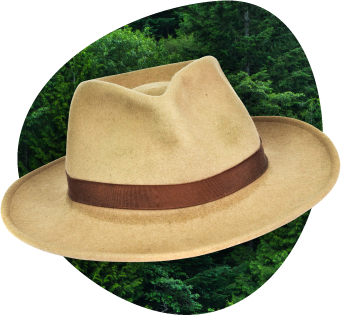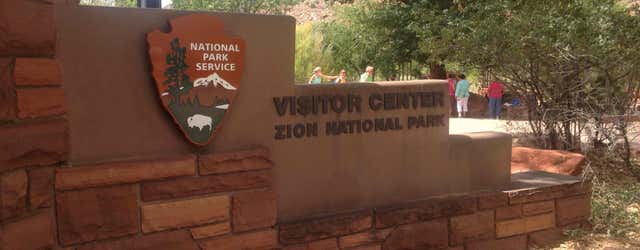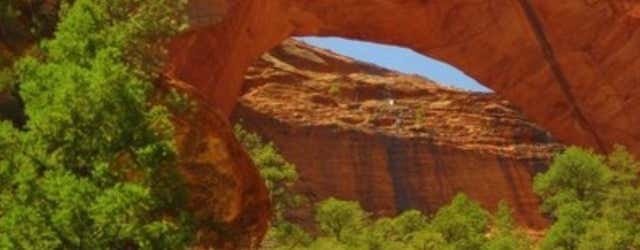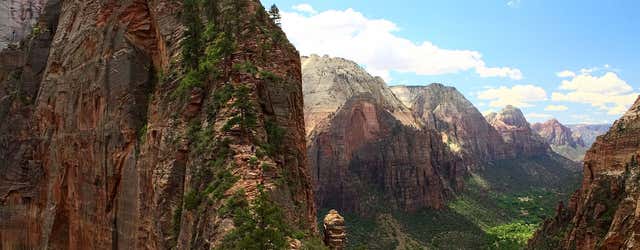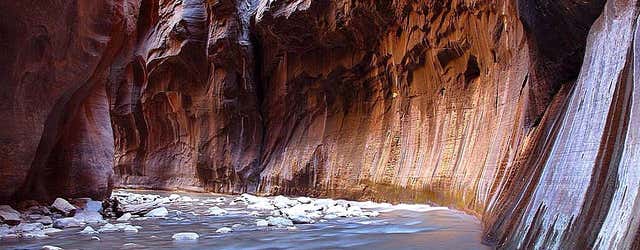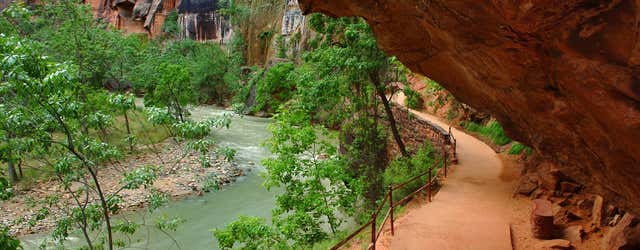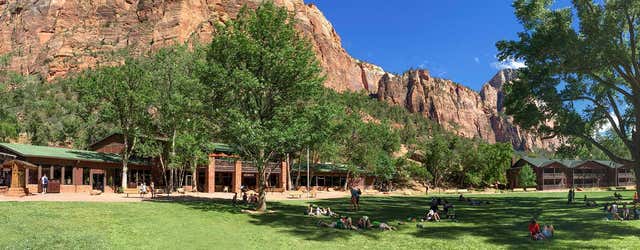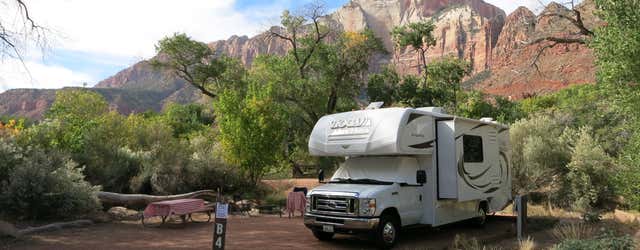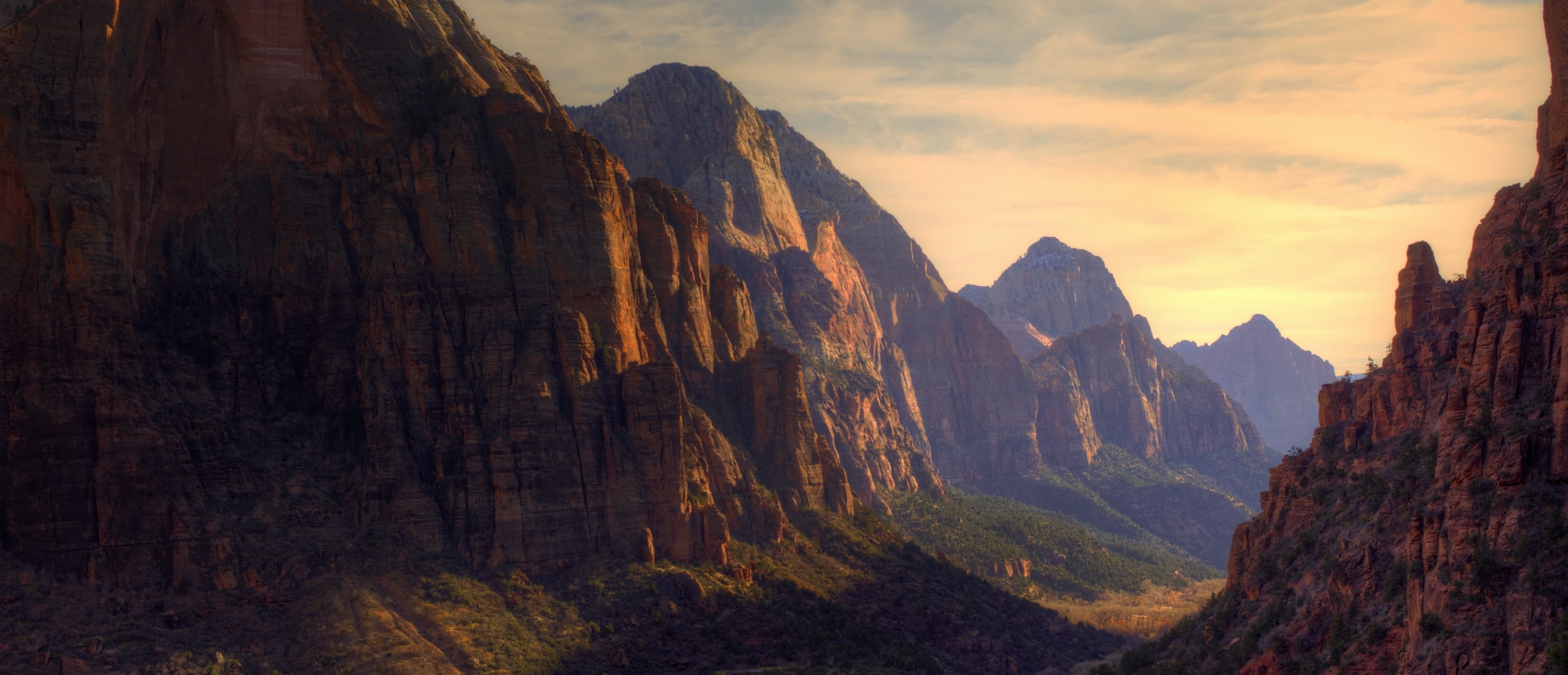
Planning a trip to Zion National Park
With insider tips from real park rangers
The jewel of Utah’s Mighty Five national parks, Zion is home to some of the most iconic views and trails in the National Park Service. And everyone seems to know it. Overcrowding at this park is common. But if you know where to go, you can find an escape on even the busiest of summer weekends.
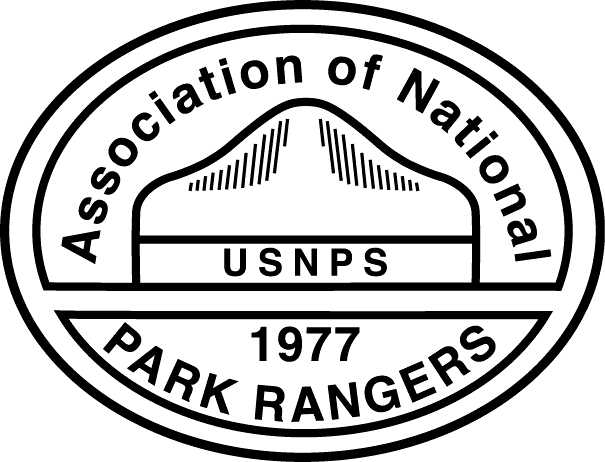
Written for you by park rangers
Who knows a national park best? Yep, the rangers who live and breathe its fresh, clean air every day. That’s who we turned to for help in creating this guide. Roadtrippers has partnered with the Association of National Park Rangers and convinced its rangers to spill their secrets for your benefit.
Getting to Zion National Park
Las Vegas’ McCarran International Airport (LAS) is the closest major airport to Zion. From Las Vegas, the drive is about three hours. Alternatively, you could fly into Salt Lake City (SLC) and drive five hours to the park. There’s a smaller airport in St. George (SGU) which has service on American (from Dallas and Phoenix), Delta (from Salt Lake City), and United (from Denver and Los Angeles). While the airport is conveniently located just an hour from the park gates, flights tend to be more expensive.
Because of astronomical visitation numbers, the park has increased service on the free Zion Canyon Shuttle through the park. It now runs daily from March to November with some additional weekends in February. During these periods, shuttles arrive as often as every seven minutes. However, simply getting into the park and finding a parking spot can still be extremely challenging. By 9 a.m., most lots are full. Consider paying for parking in the gateway town of Springdale and hopping on the free Springdale Shuttle to the visitor center.
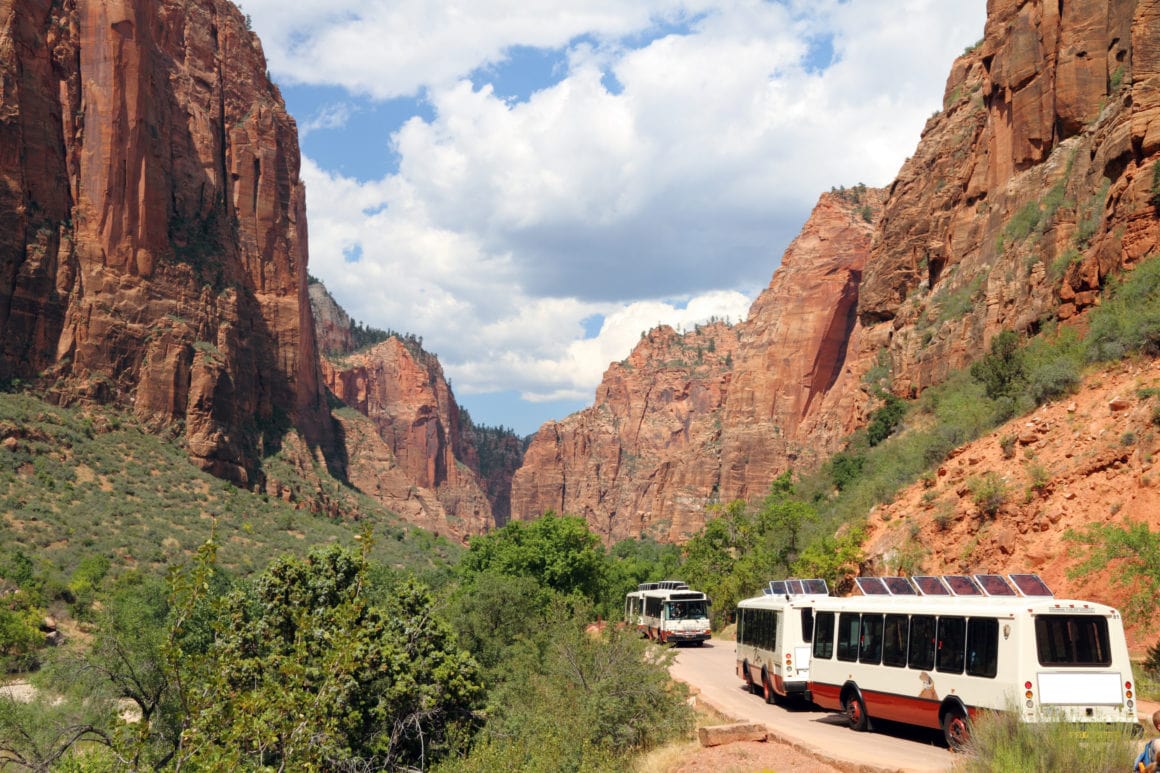
When the Zion Canyon Shuttle is running, you can’t take your own vehicle on Zion Canyon Scenic Drive, but you can drive on Highway 9 through the southern portion of the park from Mount Carmel Junction to Springdale. Regardless of whether you’re just driving through or not, you’ll be required to pay the park entrance fee. Large vehicles (wider than 7’10” and/or taller than 11’4”) are required to pay an additional $15 for a tunnel permit and must be escorted through the Zion-Mount Carmel Tunnel. Escort hours vary; make sure to check online in advance. Some vehicles are prohibited, so read the rules prior to your visit.
Timing your visit to Zion National Park
Unlike many national parks, Zion is a year-round destination. Peak visitation spans nearly the entire year with large crowds possible from February through November. Know that no matter when you visit, the temperature will likely change dramatically throughout the day—sometimes by as much as 30°F—so wear layers.
Utah schools have a fall break in mid-October that may not be on your radar when planning a visit. After all, October is typically an ideal time to visit most national parks because of decent weather and thinner crowds. However, at Zion, the crowds seen during fall break can rival those seen during the summer season.
Things to do in Zion National Park
With close proximity to Springdale and seamless shuttle access, Zion is one of the easiest national parks to get to, which is both a blessing and a curse. Crowding here is a real issue. But the scenery is so stunning, you’ll find it worth any inconvenience.
Zion has two regions: the uber-popular Zion Canyon and less-visited Kolob Canyons. While Zion Canyon has the famous sites, Kolob offers impressive landscapes on long-distance trails. In fact, the trails here only see 20 percent of the Zion Canyon traffic.
Visitor centers
Zion has two visitor centers: Zion Canyon Visitor Center near the south entrance in Springdale and Kolob Canyons Visitor Center in the northwest corner of the park. Both centers are staffed by rangers who can answer any questions that you may have about your visit. Plus, check out the long list of ranger-led activities throughout the park.
Visitors can see the 22-minute park film at the Zion Human History Museum near the south entrance. You also can stop in the Zion Nature Center just north of South Campground.
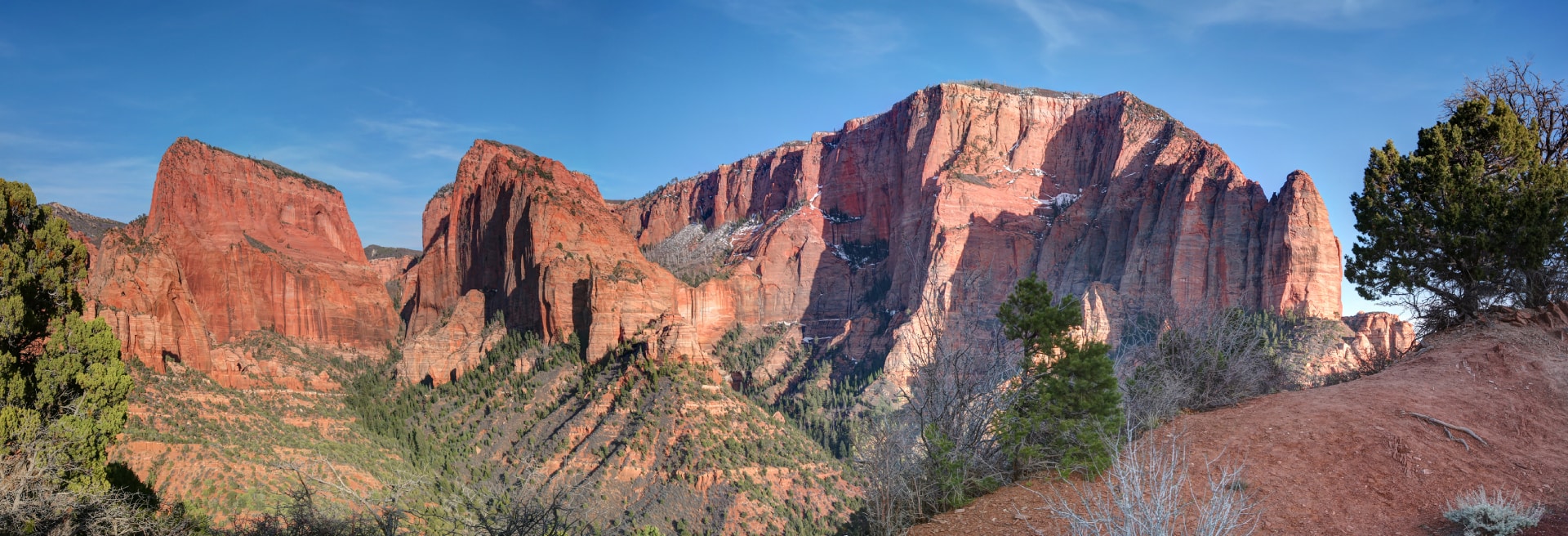
If you’re visiting with kids (ages 4-13), pick up their Junior Ranger booklets at any visitor center—or better yet, avoid the long lines at the information desk by downloading them online before you come.
Sunrise, sunset, and star viewing
For one of the most memorable moments of your Zion vacation, you’ll need to wake up early… really early. Watch the changing colors on the rocks as the sun creeps up at the Canyon Overlook Trail viewpoint. You’ll need to make a pre-dawn drive to the Upper East Canyon and hike in about a half mile. Make sure to arrive early enough; you won’t want to miss it. Another good location for sunrise photography is the Towers of the Virgin behind the Zion Nature Center.
For sunset, head to the bridge over the Virgin River near the Canyon Junction shuttle stop or go to the viewpoint at the end of Kolob Canyons Road. The sand formations along Kolob Canyon Terrace also are dramatic in the late-afternoon sun.
The night skies over Zion are something to behold. Again, the Kolob Canyons Viewpoint is a perfect spot. Look eastward toward the cliffs for the darkest skies. In Zion Canyon, watch from the museum patio or paved Pa’rus Trail.
Biking
Biking is permitted on all park roads including Zion Canyon Scenic Drive and on Pa’rus Trail, a 1.75-mile paved path that hugs the Virgin River from the Zion Canyon Visitor Center to Canyon Junction. You’re not allowed to ride your bike through the Zion-Mount Carmel Tunnel.
Hiking in Zion National Park
Know this: It’s impossible to have a bad view in Zion. So while you may be tempted to head out on the most well-trodden hikes in the park, the reality is that on busy days, you’re not going to enjoy yourself as much if you’re sharing the trails with hordes of people. Remember, there are more trails in the park than just Angel’s Landing and The Narrows.
Zion Canyon
Emerald Pools
The Lower Emerald Pool Trail is an easy, family-friendly, 1.2-mile (round trip) paved path that leads to the gorgeous green waters of the Lower Emerald Pool and waterfalls. The entire hike takes about an hour. The Upper Emerald Pool Trail is slightly more challenging, as it climbs to the pool at the base of a cliff. It’s a 3-mile hike when added to the end of the Kayenta Trail.
Weeping Rock
Short and steep, the Weeping Rock Trail showcases Zion’s hanging gardens. Here you can catch water droplets that have been making their way through the canyon walls for 1,200 years.
Angel’s Landing
The 5.4-mile (round trip) Angel’s Landing Trail (via the West Rim Trail) is not for the faint of heart. The trail has steep drop-offs, and there are sections where only a chain provides support as visitors pass in both directions. The trail takes you to a central peak in the middle of Zion Canyon. The out-and-back trail includes 1,500 feet of elevation gain and takes roughly four hours to hike. If you’re not confident in your own footing, do not hike this trail. Furthermore, it’s not appropriate for young children or those with a fear of heights. If you’re looking for an easier option, choose the 1-mile (round trip) Canyon Overlook Trail. Located on the east side of the Zion-Mount Carmel Tunnel, this trail is not on the shuttle route and requires you to drive your own vehicle to the trailhead.
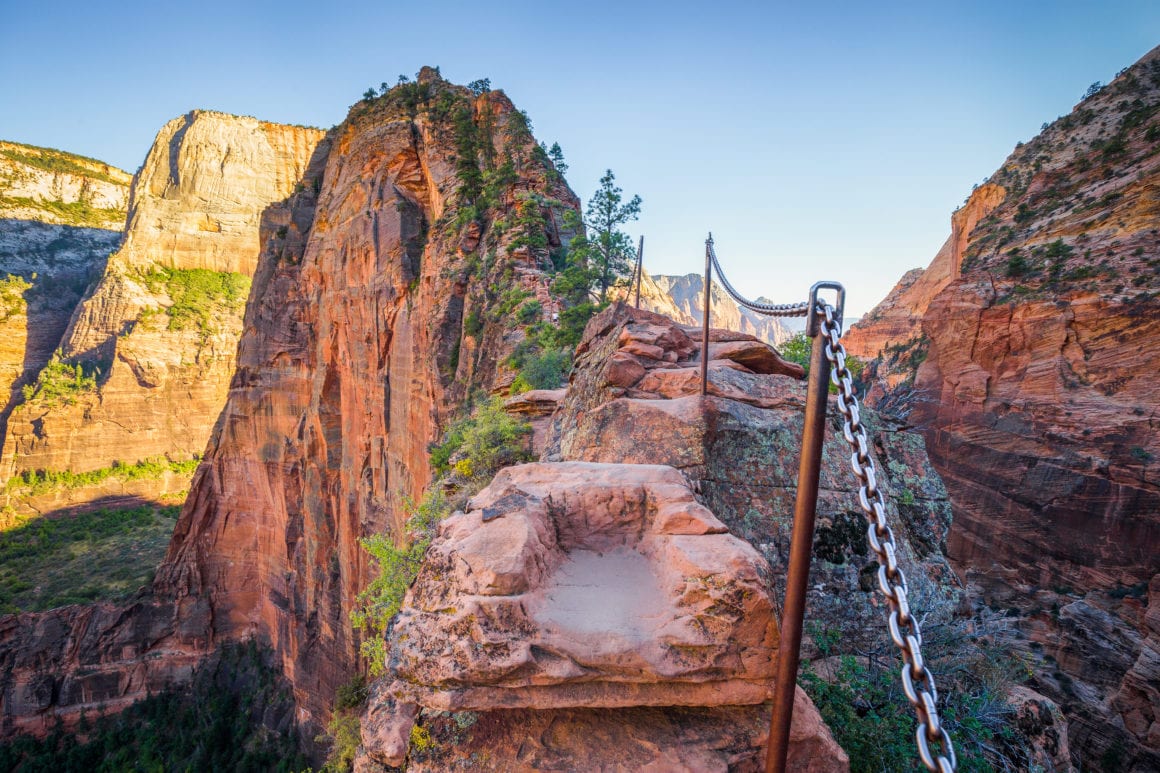
Parking is extremely limited here, so arrive early in the day.
The Narrows
The Narrows is an unforgettable gorge with soaring walls, sandstone grottos, natural springs, and hanging gardens in the upper reaches of Zion Canyon. It measures 16 miles long, up to 2,000 feet deep, and at points, only 20 to 30 feet wide. It’s a hike not to be taken lightly.
You begin the hike at Temple of Sinawava on the paved Riverside Walk that follows the Virgin River. This trail is popular and quite crowded. The herd starts to thin when you reach the river crossing. From this point on, hiking The Narrows means hiking in the river. In fact, at least 60 percent of the hike is spent wading, walking, or swimming in the water; proper footwear is imperative.
The river is cold, no matter how hot the day may be, and much of the hike is in the shade.
Before you attempt to hike The Narrows, make sure to check in with park rangers at the visitor center. There is a real and serious threat of flash flooding in the gorge, especially in mid-summer and fall. It’s safest to hike when there’s little chance of rain in the forecast. If you heed the warnings and prepare for the conditions, this hike likely will be the most memorable of your trip.
The water can get deep for young children; consider hiking The Narrows with older children only.
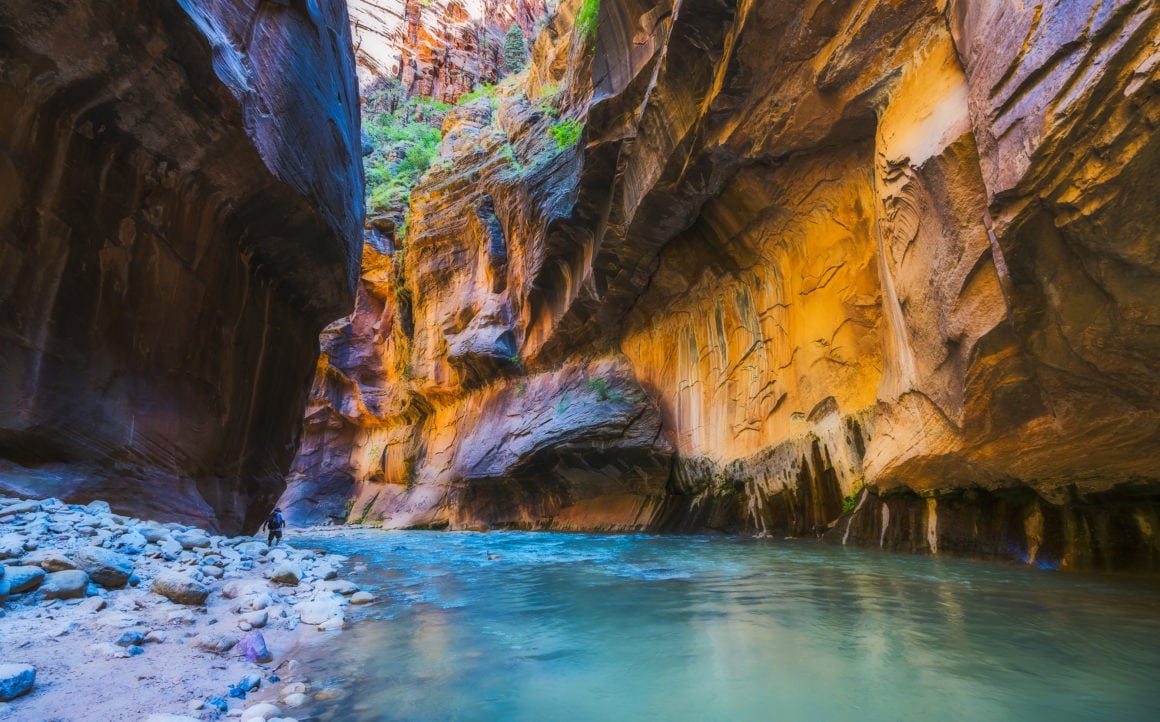
If you’re looking to do the more grueling 16-mile, 12-hour hike from the top of The Narrows or to camp overnight, you’ll need a permit.
Kolob Canyons
If the crowds are thick, consider hiking the 14-mile (round trip) trail to Kolob Arch, one of the largest natural arches on earth. Alternatively, if you’re just looking for views on this side of the park, consider the Timber Creek Overlook Trail where you can see as far as Mt. Trumbull in the Grand Canyon.
If you visit during the spring, this section of the park puts on a colorful wildflower show.
Staying in and around Zion
The two most popular campgrounds in Zion are South (no RV hookups) and Watchman (some electric sites) near the south entrance; reservations are imperative. Many of the sites are fully exposed to the sun, so expect it to be hot, especially during the summer; the riverside sites are the most desirable.
Lava Point Campground is about a 1-hour drive from Zion Canyon on the Kolob Terrace Road. It has six primitive campsites, available on a first-come, first-served basis. RVs longer than 19 feet are not allowed on the road to the campground.
There are no campgrounds in Kolob Canyons.
In the center of Zion Canyon, Zion Lodge offers year-round accommodations: historic cabins with two double beds, gas-log fireplace and private porch; and hotel rooms with a private porch or balcony.
In nearby Springdale, expect prices to be on the high side and don’t arrive without reservations. Cliffrose Springdale is just a 10-minute walk to the visitor center. The Cable Mountain Lodge holds the distinction of being the closest to the park’s boundary and has the added benefit of larger units with multiple bedrooms and full kitchens. It’s a great option if you’re part of a larger group visiting the park.
St. George has numerous hotels that can accommodate most budgets and is about an hour’s drive from the south entrance.
Eating in and around Zion National Park
At Zion Lodge, you’ll find Castle Dome Cafe, a seasonal snack bar with patio seating and more upscale Red Rock Grill with impressive views.
From the visitor center, you can walk into Springdale for a bite to eat. Some favorite spots include:
- Zion Canyon Brew Pub: This restaurant boasts outdoor seating mere feet from the park boundary, but admittedly, you pay for the convenience. Instead of a full meal, this ranger recommends drinks and a plate of loaded nachos.
- Cafe Soleil: If you’re looking to pick up a picnic lunch, stop here for wraps, sandwiches, and paninis.
- The Park House: In the morning, fuel up before heading out on the trails. The restaurant caters to those looking for vegetarian or vegan options.
How many days should you plan to spend in Zion National Park?
While its massive backcountry trail system can make for an incredible extended stay, the unbridled beauty from basically any spot in the park coupled with easy access makes Zion a perfect one-day trip. However, if it’s your first visit, try to spend at least two or three nights and venture to both Zion Canyon and Kolob Canyons.
For the perfect road trip, combine a trip to Zion with these other national parks: Arches, Canyonlands, Bryce Canyon, Capitol Reef, and the north rim of the Grand Canyon.
Add Natural Bridges National Monument to the list. It’s an undiscovered gem.
Image header credit: Shutterstock
